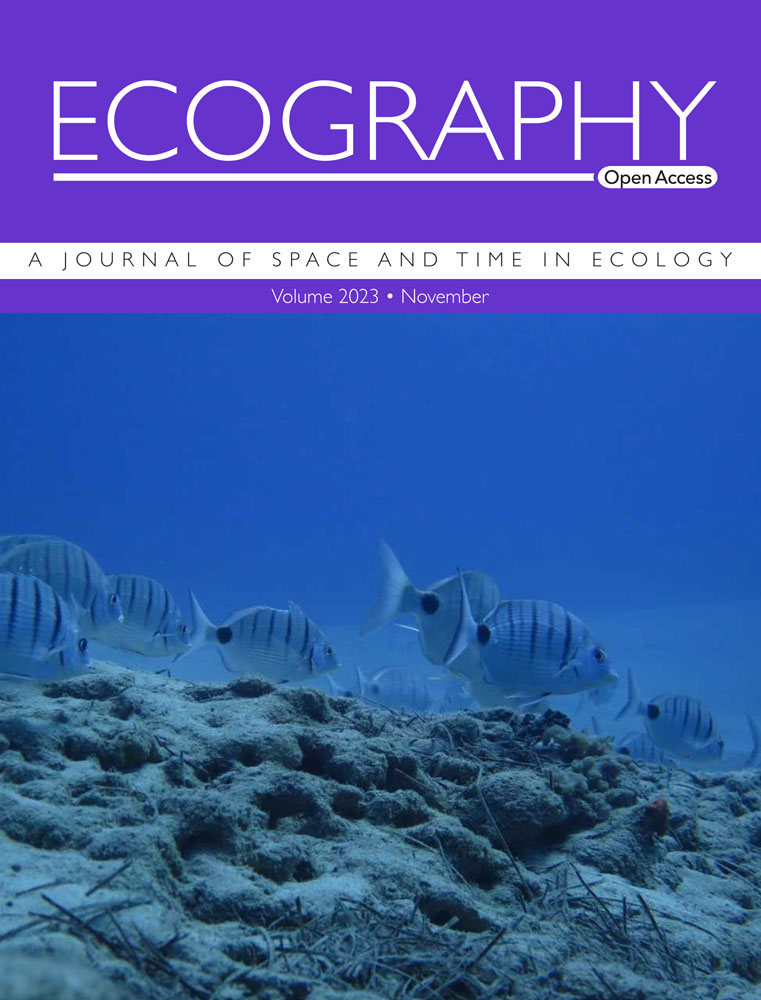如果磁带再次播放:两个热带鞘翅目组合中枝大小和分类组成的趋同进化
IF 5.4
1区 环境科学与生态学
Q1 BIODIVERSITY CONSERVATION
引用次数: 0
摘要
世界各地的昆虫群落是由独特的物种组成的,这些物种在不同的历史过程中进化而来。全群落系统发育学可以划分不同地点的共享的和独特的演化历史。我们使用了>;对马来西亚和巴拿马热带低地雨林中两个鞘翅目(甲虫)群落各1000种进行系统发育重建和群落生态分析。在种水平上,这些组合完全不同,但在科水平上,它们的总体组成和相对物种丰富度却惊人地相似。这种模式,再加上高度的系统发育聚类,表明谱系特异性倾向在不同区域驱动了进化上独立但平行的多样化。物种贫乏谱系的存在降低了两个样点的群落聚集水平,表明谱系特异性因子在物种丰富度和群落组成的形成中起着重要作用。我们的研究结果揭示了本地群落的相对物种丰富度与全球进化枝大小之间的密切联系,以及跨组合的一致的系统发育模式。虽然深层生物交换可能起着次要作用,但主要驱动因素似乎是每个进化枝(科)特有的内在多样化率。这样的动态使得组合组成更加可预测,也就是说,无论热带森林中出现新的鞘翅目组合,重新播放“进化磁带”都会产生类似的结果。本文章由计算机程序翻译,如有差异,请以英文原文为准。
If the tape were played again: convergent evolution of clade sizes and taxonomic composition in two tropical assemblages of Coleoptera
Communities of insects around the world consist of unique sets of species that have evolved under different historical processes of assembly and lineage diversification. Whole-community phylogenetics can partition the shared and uniquely derived evolutionary history across sites. We used mitochondrial genome sequences of > 1000 species each from two assemblages of Coleoptera (beetles) in distantly situated tropical lowland rainforests of Malaysia and Panama for phylogenetic reconstruction and community ecological analysis. Assemblages were entirely distinct at the species level but were surprisingly similar at the family level in their overall composition and relative species richness. This pattern, coupled with a high degree of phylogenetic clustering, suggests that lineage-specific tendencies have driven evolutionarily independent yet parallel diversification across distinct regions. The inclusion of species-poor lineages reduced the level of community clustering in parallel in both sites, indicating the role of lineage-specific factors in shaping species richness and local community composition. Our findings reveal a strong connection between relative species richness in local communities and global clade sizes, and consistent phylogenetic patterns across assemblages. While biotic exchange in deep time likely played a secondary role, the primary driver appears to be the intrinsic diversification rates unique to each clade (family). Such dynamics make assembly composition more predictable, i.e. replaying the ‘evolutionary tape' would yield similar outcomes wherever a new assemblage of tropical-forest Coleoptera arises.
求助全文
通过发布文献求助,成功后即可免费获取论文全文。
去求助
来源期刊

Ecography
环境科学-生态学
CiteScore
11.60
自引率
3.40%
发文量
122
审稿时长
8-16 weeks
期刊介绍:
ECOGRAPHY publishes exciting, novel, and important articles that significantly advance understanding of ecological or biodiversity patterns in space or time. Papers focusing on conservation or restoration are welcomed, provided they are anchored in ecological theory and convey a general message that goes beyond a single case study. We encourage papers that seek advancing the field through the development and testing of theory or methodology, or by proposing new tools for analysis or interpretation of ecological phenomena. Manuscripts are expected to address general principles in ecology, though they may do so using a specific model system if they adequately frame the problem relative to a generalized ecological question or problem.
Purely descriptive papers are considered only if breaking new ground and/or describing patterns seldom explored. Studies focused on a single species or single location are generally discouraged unless they make a significant contribution to advancing general theory or understanding of biodiversity patterns and processes. Manuscripts merely confirming or marginally extending results of previous work are unlikely to be considered in Ecography.
Papers are judged by virtue of their originality, appeal to general interest, and their contribution to new developments in studies of spatial and temporal ecological patterns. There are no biases with regard to taxon, biome, or biogeographical area.
 求助内容:
求助内容: 应助结果提醒方式:
应助结果提醒方式:


